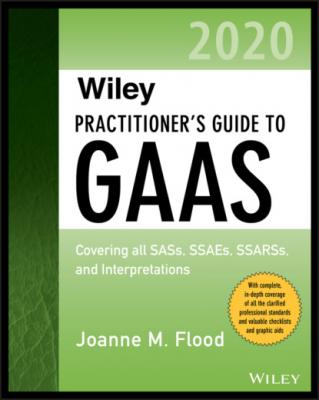Wiley Practitioner's Guide to GAAS 2020. Joanne M. Flood
Читать онлайн.| Название | Wiley Practitioner's Guide to GAAS 2020 |
|---|---|
| Автор произведения | Joanne M. Flood |
| Жанр | Бухучет, налогообложение, аудит |
| Серия | |
| Издательство | Бухучет, налогообложение, аудит |
| Год выпуска | 0 |
| isbn | 9781119596035 |
How the users use the entity’s financial statements to make decisions
The nature of the entity and the industry in which it operates
The size of the entity, the nature of its ownership, and the way it is financed
The elements of the financial statements
The entity’s ownership and financing structures
The reliability of the benchmark
(AU-C 320.A5)
Determining the Base
If the current financial statements are available, amounts from these statements may be used, or interim financial statements may be annualized. However, if significant audit adjustments are expected, an average from prior financial statements may be used. When historical data are used, the auditor should adjust the data for unusual items that affected prior years and for any known changes that can be expected to affect the current period. (AU-C 320.A7)
Usually a single base is necessary because the auditor expresses an opinion on the financial statements taken as a whole rather than on individual financial statements. The most common bases for materiality judgments are:
Profit before tax
Total revenues
Net asset value
Other benchmarks the auditor may use include gross profit and total expenses, total equity, and profit before tax from continuing operations. (AU-C 320.A6)
Some common approaches to using these bases include, but are not limited to, the following:
Select from among the bases recognizing differences in client and industry circumstances.
For example:
If income fluctuates significantly or approaches breakeven, use total revenues.
If the entity is in an industry that is asset intensive, such as a financial institution, use total assets; if the entity is a nonprofit organization, use total revenues.
Otherwise, use income before taxes.
Use a single base that is likely to be valid across most client circumstances or industries. For example, always use the larger of total assets or total revenues.
Consider using appropriate percentages applied to different bases as the outside limits on a range, and select an amount within the range based on judgment. For example, select an amount between X% of income before taxes and Y% of total revenues.
The choice of approach is influenced by judgments about the importance of stability of the base versus flexibility in using judgment in the circumstances.
Nature of a Materiality Benchmark
Several matters should be recognized in using a benchmark to estimate an amount to be used for planning materiality. First, the amount expresses the auditor’s judgment about the total acceptable amount of undetected misstatement and detected but uncorrected misstatement. Thus, this amount in some circumstances may be larger than some auditors have considered to be material.
Second, because the amount includes an allowance for undetected misstatements and includes the combined effect of misstatements, it is not suitable as a threshold for evaluating the materiality of individual misstatements. Also, when evaluating, the auditor should consider qualitative matters and additional information obtained during the audit.
Finally, a benchmark is in no sense a rule. It is simply a guide to making a planning decision. If the benchmark produces an amount that an auditor believes is unreasonable, the auditor’s considered judgment should prevail over arbitrary adherence to the benchmark.
For smaller entities, where the owner takes a significant amount of before-tax profit, it might be prudent to use another benchmark, such as profit before distribution and tax. (AU-C 320.A10)
The auditor should determine a materiality level for the financial statements taken as a whole when establishing the overall audit strategy. This materiality, developed during the planning stage, helps guide the auditor’s judgments in:
Assessing the risks of material misstatement, and
Planning the nature, timing, and extent of further audit procedures.
(AU-C 320.11)
Revision of Materiality
During the audit, the auditor may become aware of information that indicates that a lower level of materiality is more appropriate. In that case, the auditor should consider the necessity of revising performance materiality and whether further audit procedures need to be considered. (AU-C 320.12–.13)
Documentation Requirements
The auditor should document the following:
The level of materiality for the financial statements as a whole
Materiality levels for particular classes of transactions, account balances, and disclosures
Performance materiality
Any revisions to the above during the audit
(AU-C 320.14)
12 AU-C 330 Performing Audit Procedures in Response to Assessed Risks and Evaluating the Audit Evidence Obtained
Designing Further Audit Procedures
Evaluating the Sufficiency and Appropriateness of the Audit Evidence Obtained
Misstatements Detected at Interim Dates
